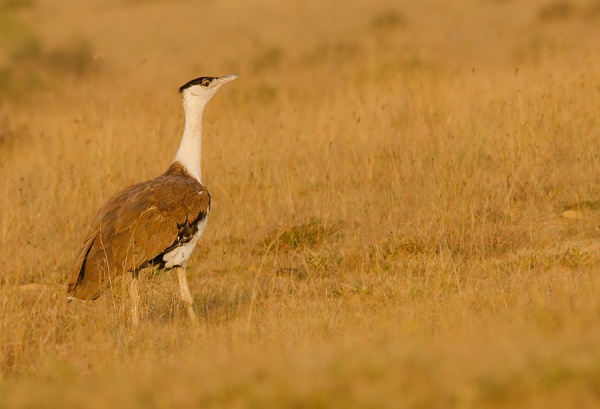Facts About Great Indian bustard
The Great Indian Bustard, also known as the Indian Bustard, is a large bird native to the Indian subcontinent. Recognizable for its horizontal body, long bare legs, and a resemblance to an ostrich, it is among the heaviest flying birds. Unfortunately, it is critically endangered, with a population of only about 150 individuals remaining as of 2018. This decline is largely due to hunting and habitat loss. The species is protected under India's Wildlife Protection Act of 1972 and is typically found in dry grasslands and scrublands, often sharing its habitat with blackbucks.
Standing approximately one meter tall, the Great Indian Bustard is easily identifiable. It has a black cap, a pale head, and a brownish body adorned with a distinctive black patch spotted with white. Males are larger than females and display a sandy buff color with a black breast band during the breeding season. Their deep, resonant calls are generated by a well-developed gular pouch. In terms of size, they are only surpassed by the Kori bustard and the great bustard, making them the largest land bird in their native range.
Once widespread across India and Pakistan, the Great Indian Bustard is now critically endangered in Pakistan and found in isolated pockets across various Indian states. They prefer arid and semi-arid grasslands, open country with thorn scrub, and areas with tall grass interspersed with cultivation, while avoiding irrigated regions. These omnivores feed on insects, grass seeds, berries, rodents, and reptiles, and their breeding season extends from March to September.
The population of Great Indian Bustards has dramatically decreased, prompting BirdLife International to classify them as Critically Endangered in 2011. Major threats include hunting and habitat loss due to agricultural expansion and irrigation projects. Conservation efforts, such as "Project Great Indian Bustard" aim to protect and restore their numbers. Although various sanctuaries and protected areas in India provide some refuge, challenges such as collisions with infrastructure and threats from renewable energy developments persist.

 Sri Lanka
Sri Lanka